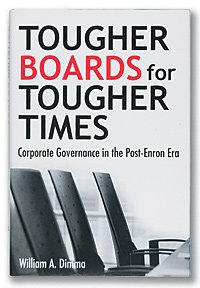Best Business Books: Governance
Still Misbehavin’
(originally published by Booz & Company) William A. Dimma,
William A. Dimma,
Tougher Boards for Tougher Times: Corporate Governance in the Post-Enron Era
(John Wiley & Sons Canada, 2006)
William Cast, M.D.,
Going South: An Inside Look at Corruption and Greed, and the Power of the HealthSouth Message Board
(Dearborn Trade Publishing, 2005)
Barton Biggs,
Hedgehogging
(John Wiley & Sons, 2006)
Pity the poor CEO or board member at a public company these days. Long gone are the good times when top executives could keep their perks — Gulfstream travel and swank apartments in New York or Paris, for example — largely secret from shareholders, regulators, and nosy journalists like me. Enron, WorldCom, Tyco, and a few lesser scandals changed all of that, and public companies now face stringent rules on disclosing both compensation and perks. Even companies that are famously unconcerned with public perception are suddenly going to great lengths to explain why perks like $1.8 million in security services for the CEO in 2006 (I’m not making this up) represent a legitimate business expense.
Of course, justifying questionable business expenses is really only a small part of the regulatory challenge facing many American companies. Several new books that explore subjects that loosely relate to corporate governance, or the lack thereof, demonstrate that Sarbanes-Oxley, the U.S. legislation passed in July 2002 and known as SOX, hasn’t entirely shut down the party. Compensation for some top executives seems to be approaching the stratosphere, and scandals, such as the options backdating issue, are hitting an expanding list of companies. And that’s really just the beginning. Nearly five years after SOX was signed, there is plenty of evidence that many corporate leaders continue to put their own interests ahead of their investors.
In the end, Sarbanes-Oxley and other measures will never be able to legislate greed out of existence. The lust for money or power or whatever drives corporate leaders to misbehave is endemic to the universe in which corporate potentates operate. These books are admirable attempts to illuminate that world and its effect on investors and other stakeholders.
 An Insider’s View
An Insider’s View
Years ago, when I worked at a newspaper that was part of a large national chain, a fellow reporter and I used to joke about the book we’d write one day when we left the newspaper industry. We’d talk about the dysfunctional management, the yes-men (and -women) who coasted on compliments, and the fact that we were expected to declare on our time sheets that we’d worked 40 hours, even though we often spent 60 or more chasing down stories. I mention this not because I’m still interested in writing that book, but because it came to mind as I was reading William A. Dimma’s excellent new book on corporate governance, Tougher Boards for Tougher Times: Corporate Governance in the Post-Enron Era.
Mr. Dimma, the former president of Toronto Star Newspapers, joined his first corporate board in 1963 and has sat on 55 for-profit corporate boards and 40 or so nonprofit boards, the majority of them in his native Canada. As a result, he offers a real insider’s view of life in the boardroom — warts, fancy retreats, and all. You know he’s calling on personal experience when he reflects on today’s CEOs: “What we seem to have spawned, not universally but too often for comfort, are individuals who are amoral at best, immoral at worst. They are egocentric, grasping, cynical and manipulative.” The situation wasn’t always this bad. Thinking back to another time, Mr. Dimma writes, “Once management served shareholders first. Or at least more frequently than today. Now too many senior executives serve themselves first.”
But Mr. Dimma hasn’t given up hope. His book is clearly intended as a call to arms for directors. Indeed, Mr. Dimma contends that committed, engaged, proactive directors are the antidote to the problems plaguing corporations. He argues forcefully for a separation of power between the chairman and CEO. The idea isn’t revolutionary; a small but growing number of American companies have begun to embrace it, mostly under pressure from institutional investors. But what makes Mr. Dimma’s position compelling is that he is a longtime director advocating for the same sorts of changes that corporate gadflies have long called for.
Mr. Dimma is particularly tough on compensation consultants. Employing them is almost always a bad idea, he writes, because of their inherent conflicts of interest: They negotiate with the board for CEO pay and perks, but stand to make much more money by providing consulting services on em-ployee benefit plans. Plus, says the author, they’re not doing much good for anyone — company, CEO, or employees. “It would be churlish of me to note any connection between the work of such firms and the children of Garrison Keillor’s Lake Wobegon, all of whom were ‘above average,’” he writes.
Stock options — an incentive that has been abused lately — also receive a fair amount of criticism, with three chapters devoted to improving the way they’re wielded. Mr. Dimma’s take is that executives often get tied up trying to maximize their paper profits and don’t spend enough time focusing on running the company. His bottom line is that companies should tread warily; stock options, he says, corrupt, and more stock options corrupt absolutely.
I have quibbles with this book, most of which relate to oddities of structure and approach. The obligatory chapter on how to avoid future Enrons, for example, offers suggestions that appear to come from people other than Mr. Dimma, though those contributors are never named. Instead, he takes the Talmudic approach, providing (in parentheses for some odd reason) his comments on these suggestions. I also found it jarring that three chapters written by guest authors are plopped into the middle of the book; they probably would have made more sense as an appendix. Although these chapters deal with specific board committees (auditing, compensation, and corporate governance) and the authors writing them are clearly experts, I’d much rather read Mr. Dimma’s views, based on his own vast experience.
Another concern is that Mr. Dimma’s frame of reference is Canadian companies, which, though similar to publicly traded American companies, are not an exact match. Mr. Dimma devotes a four-page chapter to some of the key differences and argues convincingly that the Canadian structure is more effective in preventing abuses, Conrad Black notwithstanding. As evidence, Mr. Dimma points to the fact that two-thirds of the largest Canadian companies separate the roles of chairman and CEO, whereas four-fifths of the largest American companies combine the roles.
Although Mr. Dimma, who is approaching his 80th birthday, insists that he has not yet entered his golden years, his book comes across as a swan song, one that is biting without being bitter. Many companies have long had mandatory retirement ages for their board members, so it’s not hard to imagine him having to step down from his directorships sometime soon. Because Mr. Dimma’s authority and insight elevate his work above the clamor of today’s corporate scolds, his Tougher Boards for Tougher Times is our choice for the best governance book of 2006.
People-Powered Investment Research
When a relatively unknown (albeit wealthy) businessman named Ned Lamont defeated three-term incumbent Senator Joseph Lieberman in the Connecticut Democratic primary last August, political pundits chattered incessantly about people-powered campaigns. Although it’s true that bloggers played a key role in Connecticut’s race for the U.S. Senate, it was hardly the first example of people banding together online to brainstorm and share their opinions on political races or other matters. Indeed, people have been pooling their investing knowledge for much of the past decade on stock message boards. In his first book, Going South: An Inside Look at Corruption and Greed, and the Power of the HealthSouth Message Board, William Cast takes us inside that world as it relates to one company: HealthSouth, a former Wall Street darling that imploded in 2003, eight months after Sarbanes-Oxley was signed into law. This timing made its executives the first to be charged with violating SOX. (Former CEO Richard Scrushy was acquitted of all charges related to the matter.)
Dr. Cast, a physician who found himself working for HealthSouth after the ambulatory surgery center he founded was gobbled up by a company that in turn got gobbled up by HealthSouth, is no idle observer. Trained as an ear, nose, and throat surgeon, Dr. Cast plunged into the wild and woolly world of Yahoo’s online message boards, using the screen name Charon_xxx, which I assume refers to the ferryman to Hades, although Dr. Cast never actually explains it. Draw your own conclusions. Dr. Cast’s book makes for a scary but absorbing read on how the various systems put in place after the fall of Enron, including Sarbanes-Oxley, failed to protect ordinary investors.
Message boards played a key role in adding extra froth to the technology bubble. Because people can post anonymously, with little fear of retribution, online message boards are often full of outrageous lies and half-truths, not to mention lots of salty language written by people with a vested interest (either long or short) in the stock. Indeed, one of the more surprising things to me about Going South was that real people like Dr. Cast (as opposed to anonymous crooks and speculators) actually spent time on these digital free-for-alls. He explains that his aim was to help board participants understand HealthSouth and add to his own knowledge about the company, since several of his fellow posters were also HealthSouth employees. Indeed, Dr. Cast says that reading the HealthSouth board “became one of my daily routines.”
His admiration for the message board’s power to disseminate information is obvious to even the casual reader of Going South, who may quickly grow tired of the long and frequent message excerpts from a former HealthSouth food service manager named Peter Krum. Mr. Krum, who left HealthSouth in 1997, was sued by Mr. Scrushy for libel and in February 1999 posted a long apology on the Yahoo message board (which Dr. Cast dutifully includes word for word) as part of his settlement. Dr. Cast’s claim that “message boards provide valuable access to investment information available nowhere else” also rings hollow. Although it’s true that much of this information may be unavailable anywhere else, that’s only because much of the stuff on message boards is pedantic, or outright false. Still, the idea that a group of people can meet online and work together to fact-check the fluff — from press releases to rosy earnings reports — is alluring.
 Hedging Bets
Hedging Bets
Less than a decade ago, hedge funds were an investment tool familiar to only a select group of very wealthy individuals. But over the past few years, in part due to a stricter regulatory environment for mutual funds, hedge funds have gone relatively mainstream. Although ordinary Joes still aren’t likely to have enough money to participate in one, the aura of hedge fund investing — and the widespread belief that it is as freewheeling as the Wild West — have helped pump billions of dollars into these funds. Barton Biggs, who spent more than 30 years in the trenches at Morgan Stanley, eventually rising to director of research, left the firm with two other colleagues in 2002 to form his own hedge fund. He knows of what he writes in his very entertaining book Hedgehogging.
Mr. Biggs sheds light on this rarified world populated by big swinging “masters of the universe” types. It’s a place where a mogul’s 10-year-old daughter yearns to fly like the little people for a change. “What I really want is for you to take me to a real airport, check in, go through security, get searched, stand in line, and fly commercial to someplace,” Mr. Biggs writes, recalling a conversation recounted to him by a fellow hedgehog. “Daddy, never having done that is really embarrassing.” Well, at least we have one volunteer to fly commercial, though I’m guessing that by now, the kid has grown tired of that particular type of excitement.
Such knowing detail sheds light on the clubby world of professional investors, where the Scotch and beef are always aged and the denominations of currency sloshing around have lots of zeroes. Mr. Biggs writes most engagingly when he takes readers inside such exclusive sanctums as Morgan Stanley’s annual hedge fund conference at the Breakers in Palm Beach: “There are many tribes at the conference. First, there are the professionals.... They have bored, cynical stares and limp handshakes. Then there is the rest of the crowd, the amateurs, mostly wealthy individuals and small, wannabe funds of funds. Germans with bulging eurobellies from family offices mingle with bloated Arabs in pale suits and white shirts, their handshakes as cool and clammy as snakeskin” and “vastly rich investors with homes in three climates” and “wealthy divorcees and widows with artificial brightness in their un-pouched eyes. Are they looking for a man or a hedge fund?”
After a while, Biggs’s descriptions of women, in particular, as greedy and way too possessive of their husbands’ hard-earned money, not to mention overly nipped and tucked, grow tiresome. Although the world of hedge funds is still dominated by men, it’s hard to believe that there aren’t a few smart women in there. Biggs does attempt to address this two-thirds of the way into the book, explaining that although the “vast majority of male investors accept that women are just as smart as men,” they “don’t believe that women are capable of playing the money game.” Equally frustrating is that Mr. Biggs admits to using composite characters so readers won’t be able to identify individuals. This technique doesn’t belong in a work of nonfiction. Despite these shortcomings, the book is a very enjoyable, not to mention insightful, examination of an echelon that most of us know very little about, but that controls an ever-larger chunk of the world’s assets.
All three of these books illustrate in vivid detail just how much corporate governance has changed over the past five years. Questioning a CEO’s business decisions or even his management style used to be the province of corporate gadflies who would vent their frustration at the annual meeting and be viewed as a sideshow. Now, even professional money managers — the polar opposite of the lone shareholder — are voicing their concerns, and with surprising results. Their interest and, perhaps more important, their votes, have led to radical changes at several large companies, including Disney and Ford Motors Company. Is there more work to be done? Absolutely. With more than 13,000 publicly traded companies out there, it’s hard to snap your fingers and institute a “shareholders first” strategy overnight. But given the massive abuses that investors have experienced, even small changes are welcome.![]()
Author profile:
Michelle Leder (ml@footnoted.org) is founder and editor of footnoted.org, a Web site focused on governance issues. She is the author of Financial Fine Print: Uncovering a Company’s True Value (Wiley, 2003).

